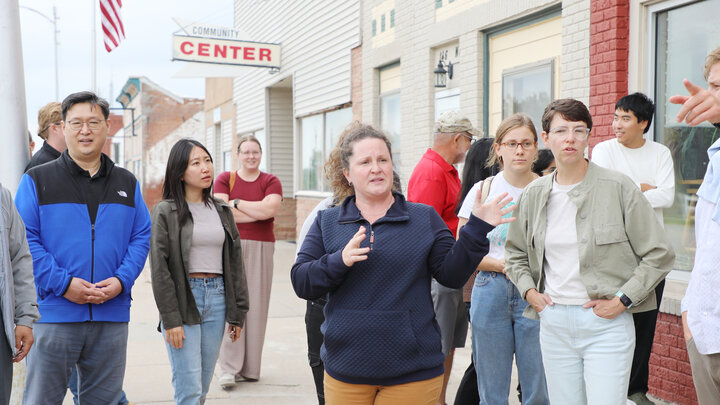In the wake of disastrous floods that have inundated other parts of the country, University of Nebraska–Lincoln (UNL) researchers say Nebraska could experience similar devastation, with the consequences falling disproportionately on the state’s most vulnerable residents. A new study, prompted by Nebraska’s catastrophic 2019 floods, concludes that thousands of people living in mobile home parks across Dodge, Douglas and Sarpy counties reside in federally designated flood hazard areas.
The research team, led by Zhenghong Tang, a professor of community and regional planning at UNL, published its findings in the journal Natural Hazards. By analyzing data from individual buildings across 23 mobile home parks, the study found that about one in five mobile homes in Douglas County—and half of those in Dodge County—are located within high-risk flood zones. With an average household size of 2.5 people, the team estimates that roughly 1,230 residents—most living in Fremont and northeast Omaha—are exposed to significant flood danger.
Researchers note that many mobile home parks face heightened flood risks not just because of their location, but also due to a lack of basic protective infrastructure. Dodge County, for example, has no levees shielding its mobile home parks, while Douglas County’s levee system along the Missouri River has held back floodwaters in recent years. These vulnerabilities are compounded by limited access to reliable communication, as spotty cellular coverage and limited broadband in some areas can hamper emergency warnings.
Internal park layouts add another layer of risk. Some parks have just one road in and out or a network of dead-end streets—conditions that can trap residents during a flash flood. The study found that mobile home parks with the lowest road connectivity were also the most likely to be in a flood plain.
“This is a perfect storm of vulnerability,” said Tang. “You have aging, low-cost homes located in risky areas, served by weak infrastructure and occupied by residents with fewer resources and fewer options.”
The issue isn’t hypothetical. The 2019 ‘bomb cyclone,’ and flooding that spanned from March to July of that year, caused significant damage across Nebraska. Damage estimates range from $1.3-3 billion. The city of Fremont was completely cut off by floodwater and transportation was disrupted across the state for an extended period, leaving many Nebraskans unable to reach their homes or places of work. The Nebraska Department of Economic Development (DED) acknowledged the devastating effects the 2019 disaster had on affordable housing; particularly in the counties of Sarpy, Dodge and Douglas, where there is a high density of mobile homes. Nearly one-third of those that applied for federal housing assistance following the disaster were renters. Several mobile home parks in Sarpy County were inundated and one park permanently closed after a levee failure.
“Response and recovery are exceedingly costly. An investment in risk awareness and resilience can help mitigate and reduce those costs. To reduce future devastation of floods, it is necessary to better understand our risk,” said Jenny B. Mason, director of community development and disaster recovery at DED, which awarded federal disaster funding to UNL to develop a strategy to identify and reduce flood vulnerabilities.
Despite the damage sustained in 2019, the development of mobile home parks in high-risk areas has continued. From 2018 to 2024, the number of mobile homes grew by 17.6% in Dodge County, 7.6% in Douglas County and 6.0% in Sarpy County. This growth stems from a complex set of factors: a chronic shortage of affordable housing pushes low-income families into flood-prone parks, while local governments have allowed new parks to be built—and existing ones to remain—in known flood zones.
“While Nebraska legally requires flood risk disclosures to buyers in real estate transactions, the flood risk of the property is not necessarily communicated to renters,” said Jamie Reinke, division manager of floodplain management at the Nebraska Department of Water, Energy, and Environment (DWEE).
Reinke adds that even property owners may not fully understand their flood risk, which can change over time. Local strategies and outreach efforts—supported by DWEE—aim to help communities make risk-informed decisions and access resources like the National Flood Insurance Program. Floodplain information is available through local floodplain administrators or DWEE’s website or interactive maps.
To better prepare for flooding, the study encourages both immediate actions and longer-term planning.
In the short term, researchers suggest that local governments explore options such as adding at least two exits to every mobile home park and linking annual license renewals to the completion of basic safety improvements. They also encourage the creation of evacuation plans tailored to each park, as well as improvements to communication systems so that residents can receive timely and clear warnings during emergencies.
For the long term, the team recommends looking at ways to increase the availability of affordable housing in areas with lower flood risk. They also suggest considering investments in levees and drainage systems, as well as offering voluntary buyouts or relocation assistance for residents living in the most flood-prone parks. In addition, the study proposes the idea of updating state laws to give counties more flexibility in deciding where mobile home parks can be built.
Jesse Andrews, the study’s lead author and a postdoctoral researcher, explained that the data provides a clearer understanding of local flood risks. “Our analysis shows that roughly 1,200 mobile-home park residents in the three counties live within high-risk flood zones,” he said. “These numbers highlight how many people are exposed to flooding and can help guide future conversations about zoning, infrastructure and housing.”
“These numbers represent real people and actual potential outcomes” Tang added. “Our goal is to inform the public so they can make decisions and policies to protect these communities.”




